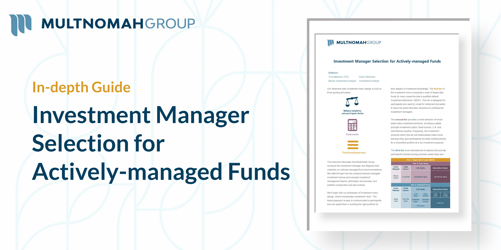Over the course of a series of blogs, our investment research team is discussing our investment manager selection process for actively-managed funds. Our first post, focused on our three guideline principles to investment menu design. Today, we are discussing what we look for within an investment team's structure.
Investment Menu Team and Organization
There are no hard and fast rules for how a team should be organized - it simply needs to make sense for the organization and support the success of the investment strategy.
Our process combines the review of information obtained from due diligence interviews with investment managers, product presentation decks, and independent fund research from third-party providers. From this information, we look for stable and experienced teams, including both PMs and analysts, who are dedicated to the success of the respective fund’s investment strategy and have incentive structures aligned to this goal.
We do not have a specific preference for the size and formation of the PM team; we accept multiple approaches including co-PM models, star manager models, and a combination of one Lead PM supported by co-PMs.
Our initial focus is on each PM’s tenure with the fund and skill set within the asset class. Unexpected changes in management are a red flag for the fund given the critical role the PMs take in executing the fund’s strategy to ultimately achieve strong and consistent relative performance.
If a PM (Lead or co-) is nearing retirement, we like to see clear communication from the firm well in advance of retirement regarding the timing of the shift and who the new PM will be. Ideally, we like to see the heir apparent taking on an active role for some time prior to passing the torch.
Also, we are concerned with additional roles that PMs take on. We carefully monitor the number of other strategies that are managed by PMs plus managerial responsibilities (e.g., CIO) that could take time away from our primary concern – adding value to investors.
Decision-making authority is key to understanding team structure – we are open to both single decision makers and team consensus methods. Overall, the manager needs to clearly articulate why this strategy works for the fund and must consistently manage to this.
With regard to analysts, the focus is on the years of experience within their respective teams as well as earlier positions and background. Many times, the PMs also act as analysts given that many of them came up through the ranks in analyst roles. We look at their assignments – whether they follow a specific sector or industry or if they are generalists. We like to see management define their analysts as “career analysts” with long tenures and strong industry knowledge. We watch turnover to see if the environment is conducive to a successful working climate.
If the manager has a centralized research unit, we seek to understand how the two teams work together. We ask management to articulate how the analysts interact with the PMs, both formally and on an informal basis. Do the analysts work hand-in-hand with the PMs or do they work independently?
We also look at the compensation structure of the team including incentives and bonuses – since we want to see staff retention and a structure that rewards individuals on a longer-term basis. If retention isn’t strong, the fund may lose a key PM which could jeopardize its future.
We also consider how much a PM owns in the fund that he or she manages as this can demonstrate the PM’s level of conviction in the fund.
There is no right or wrong way of structuring a team, but each model must make sense for their respective investment strategy.
We like to hear this articulated in a clear and concise manner with conviction that the chosen method will successfully enhance the fund’s investment process and align incentives with the interests of investors.

Our next blog in this series will focus on what we are looking for in the investment manager's philosophy and process that would to cause us to recommend a fund. If you're interested in reading our guide focused on this topic written by our senior investment analyst, Tina Beltrone, and our investment analyst, Caryn Sanchez, please click here.
Multnomah Group is a registered investment adviser, registered with the Securities and Exchange Commission. Any information contained herein or on Multnomah Group’s website is provided for educational purposes only and does not intend to make an offer or solicitation for the sale or purchase of any specific securities, investments, or investment strategies. Investments involve risk and, unless otherwise stated, are not guaranteed. Multnomah Group does not provide legal or tax advice.

